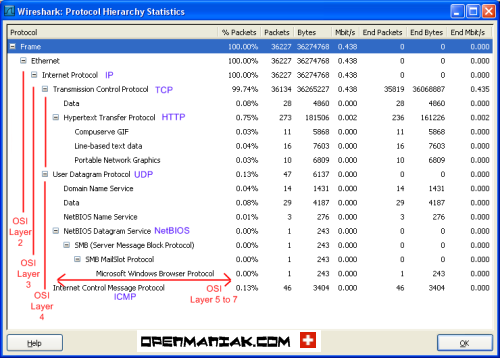

- #WIRESHARK COMMAND LINE PROTOCOLL HIERARCHY INSTALL#
- #WIRESHARK COMMAND LINE PROTOCOLL HIERARCHY FULL#
- #WIRESHARK COMMAND LINE PROTOCOLL HIERARCHY WINDOWS#
-q - don't continuously display the count of packets, just show it at the very end.There are a few commonly-used options we will use in the below examples that you should be acquainted with. Tshark should already be on your system if you already have Wireshark installed. While you won't be getting a nice graphical output of your captured traffic with tshark, you will be able to get more creative with how your data is presented and then pass it off to other command-line programs. You can think of tshark as the command-line version of the Wireshark program. See CaptureSetup/DOCSIS for more information. 'Show File Offset' adds a file offset to the frame tree, and 'Treat all frames as DOCSIS frames' forces each frame to be dissected as DOCSIS. Preference Settings Configuration options are under Edit-> Preferences.-> Protocols-> Frame.
#WIRESHARK COMMAND LINE PROTOCOLL HIERARCHY WINDOWS#
Retransmissions / duplicate ACKs / zero windows - & !_update Wireshark The frame dissector is fully functional.So I upgraded my wireshark to 3.6.5 and captured the traffic again. There are now 26 B.A.T.M.A.N packets in the 13 Frames. Some of the below might be a good starting point: Right click the Internetwork Datagram Protocol layer in the Packet Details, select Decode As. For example, we can search for the string flag in all TCP traffic with the following filter:Ībnormal TCP parameters can also be something worth looking into. We can also just try searching different raw traffic for flag-related text. Note that this technique is not a 100% surefire method of extracting every file, as some files may have been transferred in non-standard ways that Wireshark is not innately privy to. The same can be done for SMB-transferred files via the File -> Export Objects -> SMB option. Files transferred via HTTP can be extracted from a PCAP in Wireshark via the File -> Export Objects -> HTTP option. Occasionally, a PCAP challenge is only meant to involve pulling out a transferred file (via a protocol like HTTP or SMB) from the PCAP and doing some further analysis on that file. Sometimes you do not need to do much work to find a flag, and can take some shortcuts to save time. You can also exclude other traffic that isn't super interesting at first glance (like ARP) via the Apply as Filter -> Not Selected option. To start looking at a specific category of traffic identified in the protocol hierarchy, richt click the desired category and click Apply as Filter -> Selected.
#WIRESHARK COMMAND LINE PROTOCOLL HIERARCHY FULL#
For example, if you have a PCAP full of HTTPS traffic, but see a few packets of FTP data, you should probably start by looking at the FTP data. This will show you a distribution of the different protocols present within the PCAP.įollowing our goal of finding the needle in the hay stack, this is a great way to identify some low-frequency protocols for examination. You first step should be to look at the protocol hierarchy analysis, which can be done by selecting Statistics -> Protocol Hierarchy from the toolbar menu.
#WIRESHARK COMMAND LINE PROTOCOLL HIERARCHY INSTALL#
Sudo apt-get install -y wireshark tshark Scoping out a PCAP

Sudo yum install -y wireshark wireshark-gnome


 0 kommentar(er)
0 kommentar(er)
